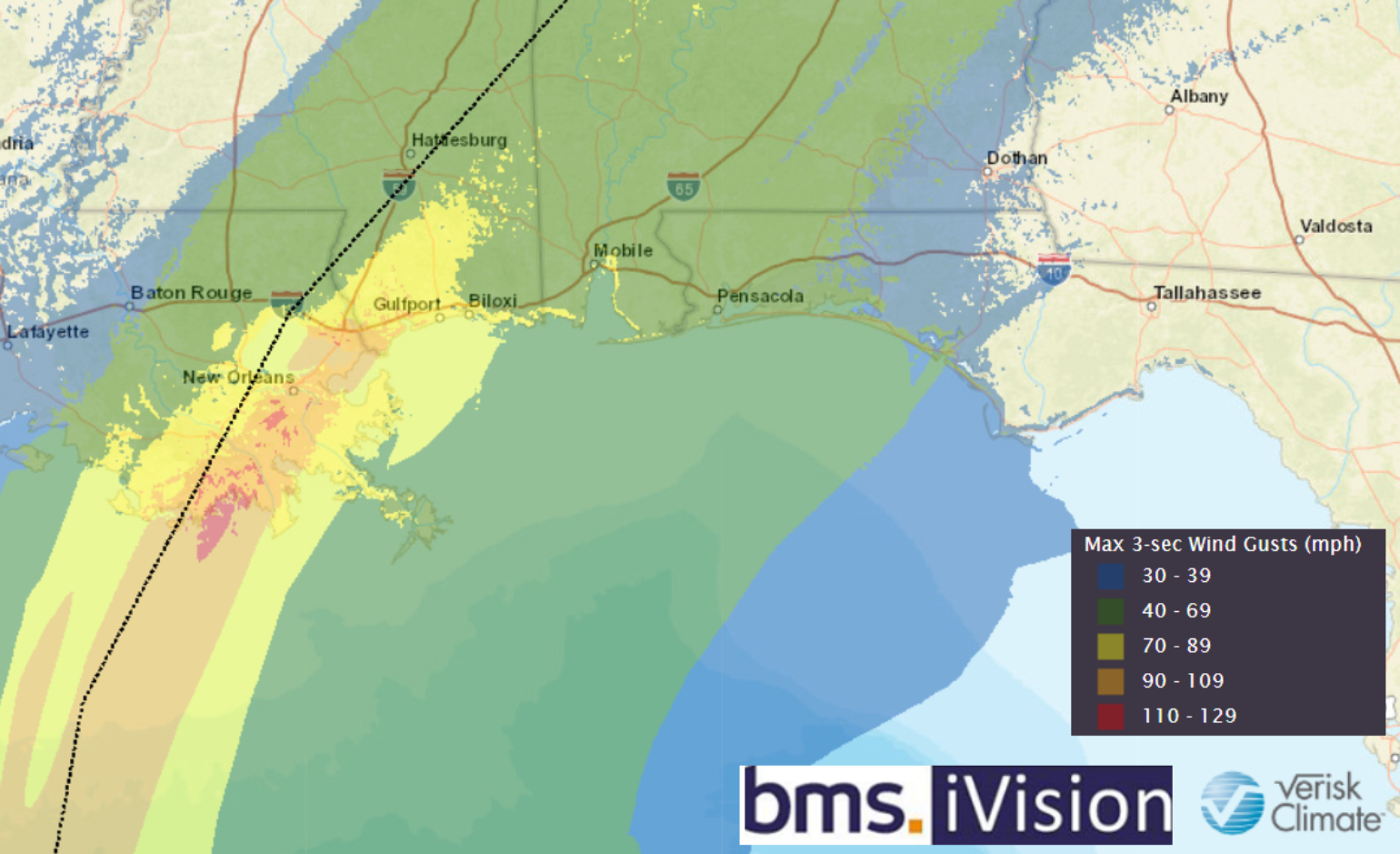By Andrew Siffert – Vice President / Senior Meteorologist
As someone who has issued over 30 BMS tropical updates so far in 2020, I completely understand that many in the insurance industry have hurricane fatigue and that this has been one long hurricane season. However, the industry cannot let its guard down yet as Hurricane Zeta could have losses of the same magnitude as some other named storms to impact the Gulf Coast this season. Zeta is expected to make landfall near the metro area of New Orleans with a population of 1.2 million. This is a lot more exposure at risk to hurricane-force winds than what was experienced during Hurricane Delta and Laura or even Sally and Pensacola, FL. As shown in the tropical update yesterday, the New Orleans area has been lucky so far this season to have largely escaped the strongest winds of these storms; but, provided the current forecast guidance, there is a high probability that the New Orleans area could take a direct hit which would be the first since Florence in 1988.
VLOG
Because there could be a bit of burnout, I have decided to record a short video blog to highlight some of the impacts from Zeta. This short 8-minute video will go into greater detail than some of the main talking points below.
Zeta Forecast
Last night around 11 pm, Hurricane Zeta made landfall just north of the resort area of Tulum, Mexico, as a Category 1 hurricane with sustained winds of 80 mph. Wind speeds to the north in Playa del Carmen gusted to 87 mph. There will no doubt be some impacts to auxiliary structures along some of the resorts that dot the coastline between Tulum and Playa del Carmen; and as daybreak occurs, social media will once again be a great source to get an initial indication of damage to the area. Zeta’s landfall in the Mexican state of Quintana Roo is the 3rd named storm to make landfall this month, with Gamma and Delta being the other two storms.
Zeta's interaction with the Yucatan Peninsula has led Zeta to stumble in intensity a bit this morning, and its maximum sustained winds no longer quite reach hurricane status. However, this will be short-lived as Zeta is expected to strengthen reasonably quickly over the warm waters of the southern Gulf of Mexico. Reintensificaiton could result in pressure around 970 mb, which would be slightly lower than the landfall pressure of 977 mb north of Tulum.
There is still a fair amount of uncertainty as to what Zeta's overall structure will look like later tomorrow in the Gulf of Mexico. Nevertheless, it appears that even with Zeta over the Yucatan, it has developed impressive outer banding overnight, extending as far as 300 miles from its center based on the satellite imagery. If this type of structure were to hold up, it would amplify the rainfall/tornado potential well east of Zeta's US landfall location, including the Florida Panhandle.
Zeta is forecasted to make landfall near New Orleans, which has not had a direct hit by a hurricane since Florence 1988, a Category 1 at landfall. Florence's angle at landfall does not match the angle at which Zeta will be making landfall. What might be a better fit is the hurricane of 1948 that hit the city in early September as a Category 1 hurricane. Below is the BMS iVision Verisk Respond 3-second wind gust product, which shows the magnitude of winds over the populated metro area of New Orleans. Therefore the critical aspect in the forecast is the track. If Zeta tracks any more west, that could put even more exposure in the general New Orleans area at risk of high winds. If the storm tracks further east, it will put less exposure at risk. We also cannot discount Gulfport and Biloxi's impacts, which will see strong hurricane-force wind gusts as Zeta makes landfall later tomorrow afternoon.

Provided that landfall will be tomorrow afternoon and Zeta is still near the Yucatan, it suggests just how fast Zeta will be moving with an expected landfall speed of at least 20 mph. This would decrease the overall asymmetry of the wind field, which would limit wind impacts on the left side of the storm, but possibly compound the impacts on the right side of the storm track. Due to the fast forward speed, storm surge and flooding rains do not appear to be a problem for the region, which is very sustainable to flooding and storm surge. If the storm were moving slower at landfall, this would be a larger problem.
Inland Impacts
The forecast models indicate that rainfall and flooding could be a much bigger problem ahead of Zeta’s landfall in the Southern Plains and Tennessee river valley. As Zeta moves inland, its fast forward motion is expected to bring damaging winds as far inland as Georgia or even the Carolinas as it merges with a mid-latitude low-pressure system. This could result in some stronger winds over New England and maybe the first snowstorm of the season for this area. However, more details on inland impacts will become more apparent over the next 24 hours, which will be highlighted in tomorrow's update.
